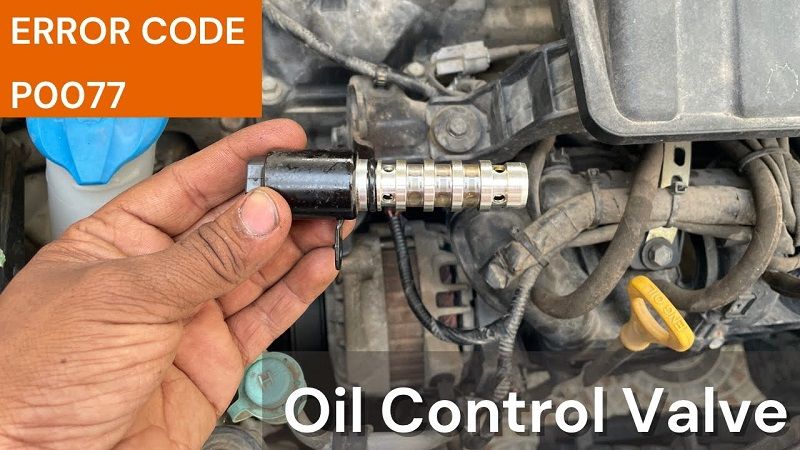This post contains affiliate links. This means I will make a commission at no extra cost to you should you click through and make a purchase [ “As an Amazon Associate, I earn from qualifying purchases.” ]. Read the full disclosure here.
Demystifying the P0077 Trouble Code: Intake Valve Control Solenoid Circuit High (Bank 1) GuideMechanic.Com In the intricate realm of automotive diagnostics, trouble codes serve as invaluable indicators, providing insights into potential issues within a vehicle’s complex systems.
Among these codes, P0077 holds significance, indicating a concern with the Intake Valve Control Solenoid Circuit High in Bank 1.
Understanding the implications of this code, its underlying causes, and how to address it is paramount for maintaining optimal vehicle performance and reliability.
See Also: P0075 Code: Intake Valve Control Solenoid Circuit (Bank 1)
P0077 Intake Valve Control Solenoid Circuit High (Bank 1)
The Role of the Intake Valve Control Solenoid:

The Intake Valve Control Solenoid plays a pivotal role in modern engine systems, regulating the airflow into the engine’s intake manifold.
Working in tandem with the engine control unit (ECU), this solenoid precisely controls the opening and closing of intake valves, optimizing engine performance, fuel efficiency, and emissions.
Deciphering the P0077 Trouble:
The P0077 trouble code specifically denotes an issue with the Intake Valve Control Solenoid Circuit High in Bank 1. It signifies that the voltage signal received from the solenoid in Bank 1 exceeds the expected threshold, indicating excessive voltage or high input.
When this code surfaces, it signals to the ECU that there is a problem with the circuit controlling the intake valve solenoid in Bank 1, potentially affecting engine performance and efficiency.
Common Causes of the P0077 Code:
Several factors may contribute to triggering the P0077 trouble code:
Faulty Intake Valve Control Solenoid:

Over time, the solenoid may degrade or malfunction due to wear and tear, exposure to high temperatures, or electrical faults. A defective solenoid may fail to operate within the specified voltage range, leading to excessive voltage output and triggering the P0077 code.
Wiring Issues:
Damaged, corroded, or loose wiring connections within the solenoid circuit can disrupt the flow of electrical signals. This can result in voltage spikes or intermittent communication between the solenoid and the vehicle’s ECU, leading to the activation of the P0077 trouble code.
Connector Problems:
Faulty connectors or poor connections between the solenoid and the vehicle’s wiring harness can impede electrical conductivity. Loose or corroded pins may cause voltage fluctuations or signal interruptions, triggering the P0077 code.
ECU Malfunction:
In rare cases, a malfunctioning ECU may incorrectly regulate the voltage supplied to the intake valve control solenoid, leading to excessive voltage output and the activation of the P0077 code.
Troubleshooting and Resolving the P0077 Code:
Addressing the P0077 trouble code requires a systematic approach to diagnosis and repair:
Diagnostic Scan:
Check out this ANCEL AD310 Classic Enhanced Universal OBD II Scanner Car Engine Fault Code Reader CAN Diagnostic Scan Tool-Black

Begin by conducting a comprehensive diagnostic scan using a compatible scan tool. Retrieve and document all stored trouble codes, including any freeze frame data associated with the P0077 code.
Visual Inspection:
Inspect the intake valve control solenoid and its surrounding components for signs of physical damage, corrosion, or contamination. Check the wiring harness and connectors for visible damage or loose connections.
Testing Solenoid Resistance:
Utilize a multimeter to test the resistance of the intake valve control solenoid. Compare the readings to specifications provided by the manufacturer. Replace the solenoid if it fails to meet the specified values.
Check Wiring and Connectors:
Inspect the wiring harness and connectors associated with the solenoid. Repair or replace any damaged wires, corroded terminals, or faulty connectors. Ensure proper routing and secure connections.
ECU Diagnosis:
If all other components check out, consider testing the functionality of the ECU. Consult the vehicle’s service manual for instructions on how to perform an ECU diagnostic test using a scan tool.
Clear Codes and Test Drive:
After completing repairs, clear the trouble codes from the ECU memory using the scan tool. Test drive the vehicle to verify that the issue has been resolved. Monitor the operation of the intake valve control solenoid and ensure it functions correctly.
Conclusion:
In conclusion, the P0077 trouble code associated with the Intake Valve Control Solenoid Circuit High in Bank 1 signifies a potential malfunction or discrepancy in the vehicle’s intake valve control system.
Understanding the causes and implications of this code is essential for diagnosing and remedying the underlying issues effectively.
By adhering to a systematic diagnostic approach and addressing any faulty components or wiring anomalies, drivers and technicians can ensure optimal engine performance and reliability.
Regular maintenance and inspection of the intake valve control system can help prevent future occurrences of the P0077 trouble code, contributing to the overall longevity of the vehicle.
See Also: P0076 Code: Intake Valve Control Solenoid Circuit Low (Bank 1)
- BMW Catalytic Converter Price: What You Need to Know - April 24, 2025
- Scrap Catalytic Converter Price - April 24, 2025
- Honda CR-V Catalytic Converter Price - April 24, 2025
